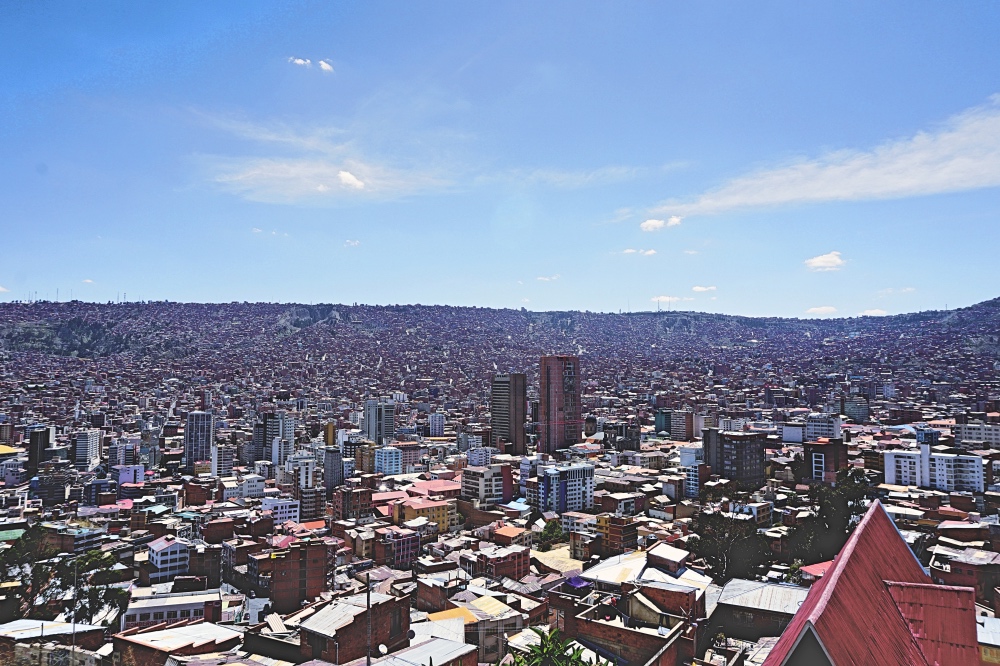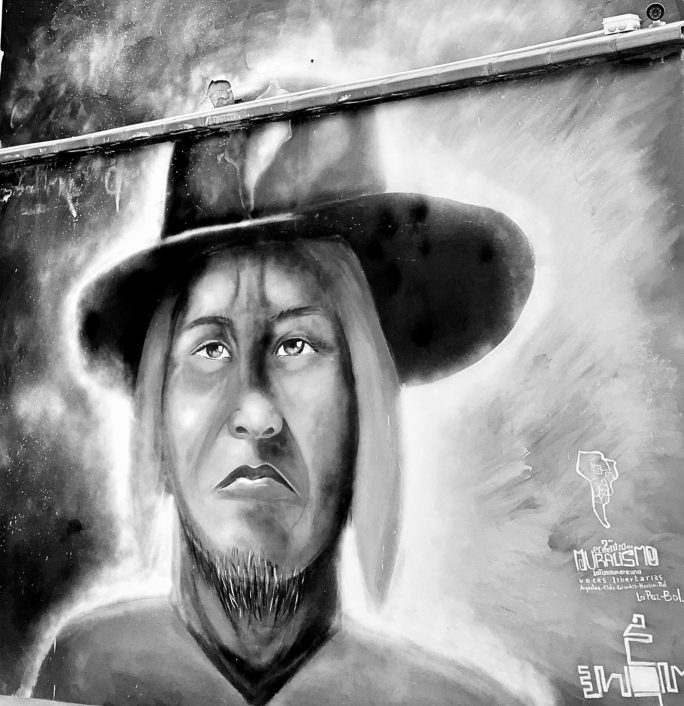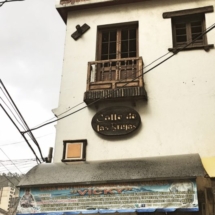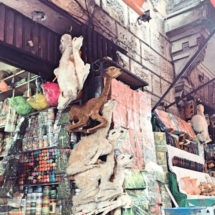🎃Elephant Cemeteries – Myth or reality?🎃
ENGLISH / ITALIANO / FRANÇAIS
🇬🇧
In the city of La Paz you will find a lot of curiosities. First its urban architecture. It is the highest capital in the world. It is located in a canyon surrounded by breathtaking mountains panoramas. Anywhere you would look, you would see a never-ending landscape of houses and constructions. The city counts with one million of citizens and on the upper part the satellite city of El Alto is spread over a broad area to the west of the canyon, counting also with one million of citizens.

El Alto is the poorer district where Aymara people, referred also as indigenous, live. In the Aymara culture, superstition and cult to Pachamama (mother earth) is still very strong nowadays. They will honor their Goddess faithfully to ensure prosperity of food, health, fertility and good luck.
One of the most emblematic character of El Alto district is the Yatari referred as “real witches”, a person practicing the rituals to Pachamama. Originally the term Yatiri was referring to “someone who knows”. They were the persons teaching within their communities because they acquired the spiritual knowledges of the universe and of the nature. By being struck by lightning, dead and reborn, they have become Yatiri.
In the actual culture, they are the psychics to whom people will refer to solve their problems of good fortune, love, health, money… The Yatiri would offer several services such as fortune teller, rituals of purification and/or curses.
El Alto district counts with a large Aymara community. It is also sad to see that it is composed mainly by the poorest part of the society, and those people who were before farming, offering and selling products on the market went forced to embrace other carrier and take jobs down in the city. Mainly they embraced constructions and labor for men while women still sell products but down in the city or at “El Ceja” market.
Bolivians love a good party, but unfortunately many people would take this lifestyle too far and end up as homeless alcoholics. This is also a direct result of this poverty developing not only in El Alto but on the upper part of La Paz, a lot of drug addiction as well as alcoholism spread over the city.
Here is one of the most terrifying and dark urban legends I have ever heard. It is known that all around the city there are “Elephant Cemeteries”.
This term refers to clandestine underground places where homeless people, drug addicts and alcoholics would go to drink themselves to death, apart from the world, like elephants where they feel the call of death.When people tired of the miserable lifestyle decide to completely give up, they would do anything to scrap together the last few coins they can find and eventually find themselves going into a hotel from which they will never return – The Elephant Cemetery.
Most of these cruel, unbelievable places would offer nothing more than a miserable room with cold cement flooring, bare brick walls, and an old mattress for the desperate drunkards to lie on as they slowly pass away drinking the awful beverage (96% of acohol) they received.

But this is not the worst part of this urban legend story. Here comes the real freaky scary part.
In the Aymara culture rituals of purification are mandatory in order get the Pachamama seal of approval. For example, when a family has a new house constructed, or a village would build a new edifice, a Yatiri would conduct a ritual placing a llama fetus beneath the building before construction begins. In order to get this ritual right, the fetuses must be naturally aborted from their mother. It is an offering to Pachamama to ensure the blessing of the building and avoid problems during construction. Aymara builders are very serious about this ritual and they will often refuse to work on a site until it got blessed.
This ritual however shows a very dark side. As mentioned before a large community of Aymaran are working nowadays in construction and labor. They will often work on large projects for the construction of high edifices, how many fetuses do you think they would need to bless such a prominent building? And would really fetus be enough for Pachamama to bless a larger, bigger, taller work? The answer is no. But what could they offer to Pachamama to satisfy her blessing gift? Try to think about it…are you getting to an answer that your mind would obviousvly refuse? Well, you were right: HUMAN SACRIFICES.
Here comes the very dark side of this story.
The legend says that in order to get human sacrifices, the Yatiri would walk around the desolated Elephant Cemeteries and other part of the cities where alcoholics, drugs addicts and desperate homeless people live. They would hide in a corner for a while observing people, checking out sordid details to select the best candidate. Once they would target their prey, they would come around and seduce them by offering them alcohol, food. They will talk to them, listen to their life stories and when they would mention no one would miss them and it would be better they die, the Yatari would give them more and more beverage until they pass out but remaining alive.
They would go on the construction site and dig a hole to bury the body. You must think how cruel is that to bury someone alive? But for the ritual to work, Pachamama should be the one taking the life away from the offering. Like the fetus would come from miscarriage, Pachamama would take away the life and last breath of a perfect victim who would anyway attempt to his days in an Elephant Cemetery sooner or later.
This legend is still a legend, nonetheless no longer than 40 years ago, human remains have been found underneath the foundations of a large demolition sites… So, myth or reality?

You must decide now what to believe, but you have been warmed… if you decide to party hard in La Paz and get offered a shot by a mystical character wearing a Borsalino you should maybe think twice before accepting it…..
🎃Le Cimetière des Éléphants – Mythe ou réalité?🎃
La ville de La Paz est un éventail de curiosités. Pour commencer son architecture. Il s’agit de la capitale la plus haute du monde. Elle est située dans une cuvette entourée d’un panorama montagneux à couper le souffle. N’importe où l’on regarde, l’horizon n’en finit plus de maisons et constructions en tout genre. La ville compte un million d’habitants. Sur la partie haute, la ville satellite El Alto s’étend sur le flanc Est de cette vallée, et compte également un million d’habitants.
 El Alto est la partie la plus pauvre de cette zone urbaine. Ici vivent majoritairement la communauté Aymara communément appelé “indigènes”. Dans la culture Aymara, la superstition et le culte à Pachamama (Terre Mère) est toujours très fort de nos jours. Ils honorent leur Déesse avec beaucoup de dévotion pour assurer la prospérité de leur nourriture, santé, fertilité et bonne fortune.
El Alto est la partie la plus pauvre de cette zone urbaine. Ici vivent majoritairement la communauté Aymara communément appelé “indigènes”. Dans la culture Aymara, la superstition et le culte à Pachamama (Terre Mère) est toujours très fort de nos jours. Ils honorent leur Déesse avec beaucoup de dévotion pour assurer la prospérité de leur nourriture, santé, fertilité et bonne fortune.
Le quartier El Alto est composé par une large communauté Aymara. Il est aussi triste de constater qu’il s’agit de la partie de la population la plus pauvre de la société bolivienne. Dédiés auparavant à des activités agricoles, vendant leurs produits sur les marchés, ils sont récemment descendus vers le centre urbain pour trouver du travail. Les hommes se sont donc dirigés vers des activités dans le bâtiment et la construction. Quant aux femmes elles continuent de vendre leurs produits dans la rue ou sur les marchés, notamment le marché “El Ceja”.
Un des personnages les plus emblématiques de El Alto est le Yatari faisant référence au “vrai sorcier/sorcière”, personne pratiquant les rituels à Pachamama. Originellement, le terme Yatari signifiait “celui qui a le savoir”. Il s’agissait donc des personnes qui enseignaient dans leur communauté car elles avaient acquis les connaissances de l’univers et de la nature. Frappées à mort par la foudre, elles revenaient à la vie et devenaient alors Yatari.
Dans la culture populaire actuelle, elles sont perçues comme les médiums auxquelles les gens ont recours pour résoudre leur problème de bonne fortune, amours, santé, argent…. Le Yatari offrira alors ses services lisant les cartes pour annoncer le future, pratiquant des rituels de purification et/ou jetant des mauvais sorts.
Les Boliviens aiment faire la fête, malheureusement certains jusqu’au point d’en faire un style de vie à part entière finissant alcooliques ou sans abris. Il est vrai aussi que la pauvreté croissante dans la ville El alto et le nord de La Paz a participé à la montée croissante de la consommation de drogue, alcool auprès d’une population plus fragile socialement.
Voici le récit d’une des histoires les plus macabres et terrifiantes qu’il m’ait été donné d’entendre. Cette légende urbaine est connue comme “Le Cimetière des Éléphants”.
Ce titre intriguant est utilisé pour décrire de lugubres bar/hôtel clandestins en sous-sol où des sans-abris, drogués et alcooliques vont boire jusqu’à ce que mort s’en suive, loin du regard des autres, tels les éléphants en fin de vie. Quand ces gens désespérés de vivre leur addiction, décident de ne plus se raccrocher à cette vie de misère, ils feront l’impossible pour trouver les quelques pièces nécessaires pour acheter leur entrée dans cette ultime porte de l’enfer de laquelle ils ne reviendront jamais – Le Cimetière des Éléphants.
La plupart de ces endroits cruels et incroyables, ne leur offriront rien de plus qu’une sordide pièce en sous-sol faite de ciment froid au sol, briques aux murs et aux fenêtres, un vieux matelas usagés où ces alcooliques notoires s’allongeront buvant l’affreux breuvage (96% d’alcool pur) qui leur sera fourni pour finir leurs jours dans une longue agonie.

Mais ceci n’est pas encore le plus lugubre de cette légende urbaine. Voici maintenant la partie qui va vous hérisser le poil.
Dans la culture Aymara, les rituels de purifications sont un passage obligé pour recevoir la bénédiction de Pachamama. Par exemple, quand une famille décide de construire une nouvelle maison, ou un village de construire un nouvel édifice, un Yatari procédera avant tout à un rituel d’offrande, enterrant un fœtus de lamas dans le sol des fondations avant que la construction ne débute. Afin que ce rituel soit réalisé dans la tradition, le fœtus de lamas devra être mort de causes naturelles à savoir fausse couche. Cette offrande assurera la protection de Pachamama afin d’éviter tout désagrément ou mauvais sort lors de la construction. Les Aymara qui travaillent dans le bâtiment sont tellement ancrés dans cette tradition qu’ils refuseront de travailler sur un chantier qui n’a pas été béni au préalable.
Ce rituel, étrange en soi de nos jours, a cependant un côté bien plus obscur. Comme évoqué plus tôt, une grande partie de la communauté Aymara travaille aujourd’hui dans le bâtiment. De ce fait ils sont régulièrement en charge de gros chantiers et bâtiments. De combien de fœtus pensez-vous qu’ils auraient besoin pour bénir un chantier d’une telle ampleur ? Et quelques fœtus seraient-ils réellement suffisants pour recevoir la bénédiction de Pachamama pour un projet aussi grand ? La réponse est non. Mais alors, que pourraient-ils offrir à Pachamama pour satisfaire ses bonnes grâces ? Réfléchissez maintenant…. Pensez-vous à l’impensable ? Si oui, vous aviez raison, la réponse est belle et bien : UN SACRIFICE HUMAIN.
Nous allons maintenant entrer dans le côté le plus noir de cette histoire.
La légende dit qu’afin d’offrir un sacrifice humain, les Yatiri arpenteraient les lieux de désolations des Cimetières des Éléphants ou autres rues de dépraves et de misère, fréquentées par les alcooliques, sans abris ou drogués. Ils se cacheraient dans l’ombre d’un recoin observant les détails les plus sordides afin de choisir le parfait candidat. Une fois qu’ils auraient repéré leur proie, ils s’approcheraient les séduisant en leur offrant alcool et nourriture. Ils les feront parler afin de découvrir les moindres détails de leur misérable existence. Et lorsque que leur victime prononcerait les fatidiques mots “je ne manquerai à personne” ou “il serait préférable que je meure”, le Yatari les feraient boire jusqu’à ce qu’ils tombent inconscients mais toujours en vie.
Le Yatari se rendra alors sur le chantier de construction où il aura creusé un trou au préalable dans les fondations. C’est là qu’il enterrera vivante sa victime. Vous devez pensé qu’il s’agit d’un acte terriblement cruel ? Cependant dans la culture Aymara, pour que le rituel soit respecté dans les règles, Pachamama doit prendre la vie de la personne sacrifiée. Comme elle l’a fait avec les fœtus de lamas lors de leur avortement prématuré, Pachamama prendra la vie et le dernier souffle d’une parfaite victime qui aurait de toute façon mis fin à ses jours tôt ou tard dans un des Cimetière des Éléphants qui peuplent la ville.
Cette légende n’est qu’une légende vous me direz. Cependant il n’y a pas moins de 40 ans, des restes humains auraient été retrouvés en quantité lors de la démolition d’un important bâtiment. Alors…. Mythe ou réalité?

Vous devez maintenant décider vous-même si vous croyez ou non à cette histoire, mais vous aurez été prévenus…. Si un jour vous décidez de faire la fête à La Paz et un étrange personnage orné d’un borsalino vous approche pour vous offrir un shot…. Réfléchissez à deux fois avant de l’accepter….
🎃Cimiteri degli Elefanti – Mito o Realtà?🎃
Nella città di La Paz potrete trovare molte cose curiose. Come prima cosa, la sua architettura urbana. E’ la piu alta capitale al mondo. Si trova in una valle conca circondata da montagne ancora più alte (fino ai 6800mt) che offrono una panorama spettacolare. Case e costruzioni, antiche e moderne, si alternano a perdida d’occhio in ogni direzione. La Paz ha ufficialmente 1 milione di abitanti, più un altro milione di persone abita nel distretto di El Alto, un sobborgo della città a 4000mt.
 El Alto è il quartiere più povero della città, dove abita la maggior parte della comunità Amaya, gli indigeni di queste terre. Nella cultura Amaya superstizione ed il culto di Pachamama (la madre terra) sono tutt’oggi molto importanti. I loro dei vengono onorati per assicurare un buon raccolto, salute e prosperità.
El Alto è il quartiere più povero della città, dove abita la maggior parte della comunità Amaya, gli indigeni di queste terre. Nella cultura Amaya superstizione ed il culto di Pachamama (la madre terra) sono tutt’oggi molto importanti. I loro dei vengono onorati per assicurare un buon raccolto, salute e prosperità.
Una delle figure più emblematiche del quartiere di El Alto è lo Yatiri, ovvero uno stregone, colui che pratica rituali spiritici per Pachamama. In principio, il termine Yatiri significava “colui che conosce”. Essi erano persone acculturate che condividevano con il resto della comunità la loro sapieza. Ma come si diventa Yatiri? Devi essere colpito da un fulmine, e sopravvivere! Solo così una persona entra in vero contatto con la natura e ne acquisisce le conoscenze.
Nella cultura moderna, gli Yatiri sono persone con poteri psichici a cui le persone normali si rivolgono per risolvere i loro problemi di cuore, affari e fortuna. In pratica sono dei santoni e veggenti che svolgono anche rituali di purificazione e maledizioni.
A El Alto vivono numerosissime persone di origine Amaya, la maggior parte delle quali stenta a sopravvivere e conduce lavori semplice e faticosi. Gli uomini nei campi a coltivare, come muratori (la maggior parte) o in fabbrica i più fortunati, mentre le donne diventano “casere” al mercato.
I boliviani amano passare serate di festa, ma purtroppo molti di loro esagerano e finiscono come alcolizzati senzatetto. Il problema è centralizzato ad El Alto, ma anche in centro città non è raro vedere disperati vagabondare.
Da qui nasce una delle più terrificanti e macabre leggende urbane che ho mai sentito. E’ ben conosciuta in tutta la Bolivia. Si riferisce a hotel speciali chiamati “Cimiteri degli elefanti”
Il termine si riferisce appunto a piccoli hotel clandestini dove alcolizzati, senzatetto e tossicodipendenti vanno a bere fino a suicidarsi, lontano dal mondo e da occhi indiscreti, come elefanti quando sentono la chiamata della morte. Quando qualcuno decide di farla finita, puo fare un check-in in una stanza e bere fino a morire, il tutto per pochi bolivianos.
Queste stanze sono composte da nient’altro che un pavimento gelido in cemento, spesse pareti e a volte un materasso arrugginito, dove questi disperati vengono serviti con una bevanda al 96& di alcol che li porta lentamente al coma.
Ma questa non è la parte peggiore di questa storia. Ecco la svolta davvero dark in questa leggenda urbana
Nella cultura Aymara i rituali di purificazione sono obbligatori per ricevere la benedizione di Pachamama. Per esempio, quando una famiglia costruisce una nuova casa, o un villaggio ordina la costruzione di un nuovo edificio, uno Yatiri condurrà un rituale speciale durante il quale sotterra un feto di lama sul luogo prescelto. Per la corretta esecuzione del sacrificio, il lama deve essere morto per cause naturali. I muratori Aymara sono molto superstiziosi, e spesso si rifiutano di lavorare in un sito edilizio non purificato.
Questo rituale però nasconde un lato ancor più macrabo. Come detto prima tanti Aymara svolgono la professione di muratori e negli ultimi anni palazzi sempre più grandi sono stati costruiti a La Paz. Pensate che un feto di lama possa bastare per purificare queste edifici? Ovviamente no. Cosa possono allora offrire in sacrificio a Pachamama gli Yatiri? Se pensate che la risposta a cui state arrivando è troppo assurda… beh ricredetevi… SACRIFICI UMANI!
Ecco il finale di questa incredibile storia
La leggenda vuole che lo Yatiri, in cerca della sua preda da offrire in dono, si aggiri per la zona dei Cimiteri degli Elefanti alla ricerca di alcolizzati e vagabondi disperati. Dopo un’attenta osservazione per scovare il candidato più adatto lo Yatiri approccia il malcapitato offrendogli denaro, cibo ed ovviamente alchol. Si siede con la preda e lo invita a raccontare la sua esperienza di vita e lo ascolta dettagliatamente. Quando il poveraccio menziona che nessuno al mondo sentirà la sua mancanza e che sarebbe meglio morisse, lo Yatiri lo indurrà a bere fino allo svenimento, ma non la morte.
Lo Yatiri sposterà ora il corpo della sua vittima sacrificale nel luogo edilizio da purificare e lo seppellirà vivo. Lo Yatiri non può mai uccidere un dono a Pachamama, come per i feti di lama, deve essere Pachamama stessa a rivendicarne la morte.

Questa, come vi diranno per la strada, è solo una leggenda urbana…ma non più di 40 anni fa durante la costruzione di un grosso complesso industriale sono stati effettivamente ritrovati decine di resti umani. Mito o Realtà?
A voi la scelta, ma non dite che non vi abbbiamo avvisato. Se decidete di divertirvi e bere oltre il limite, fate molte attenzione nel caso un personaggio mistico vi approci offrendovi da bere!



No Comments